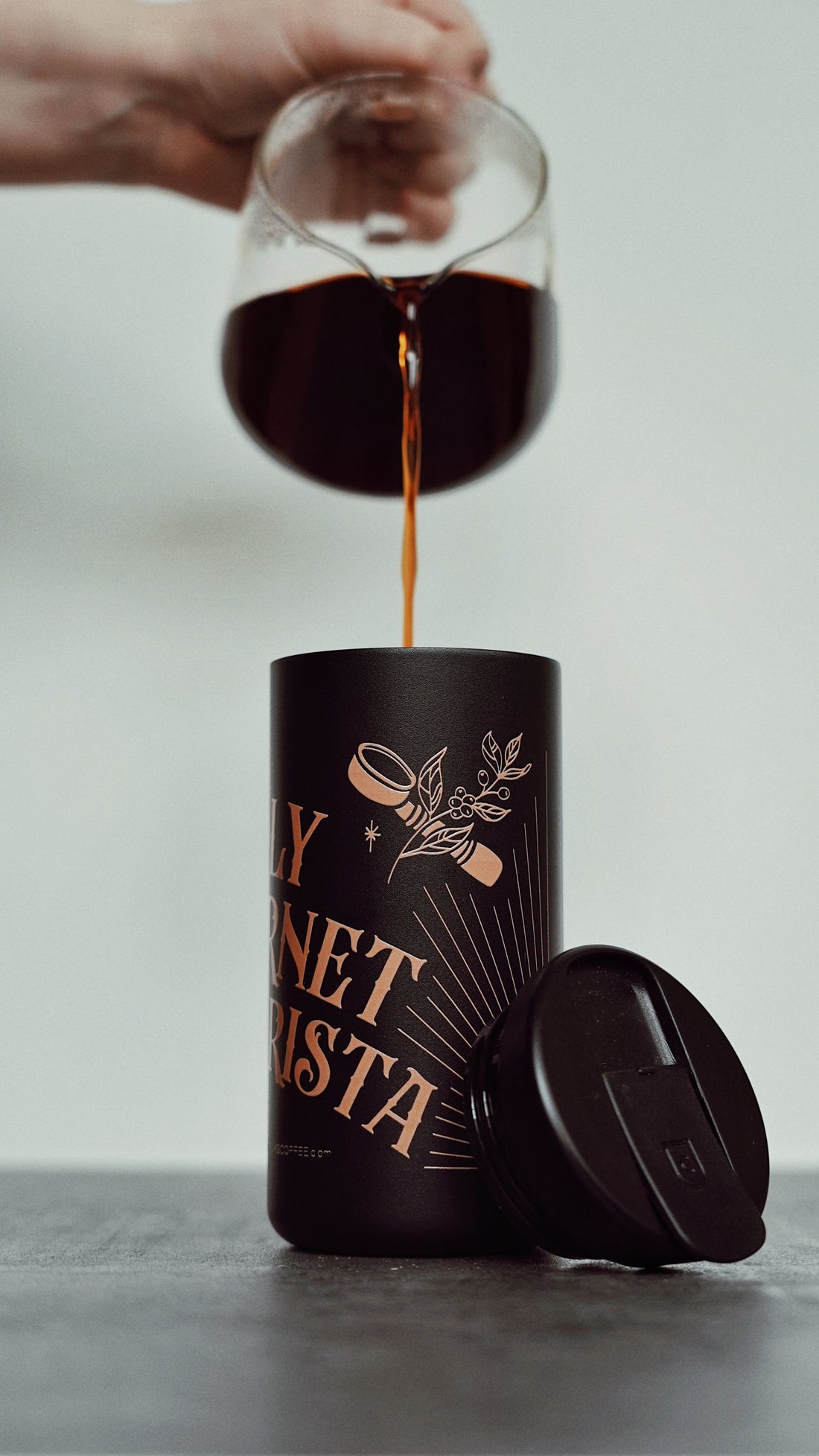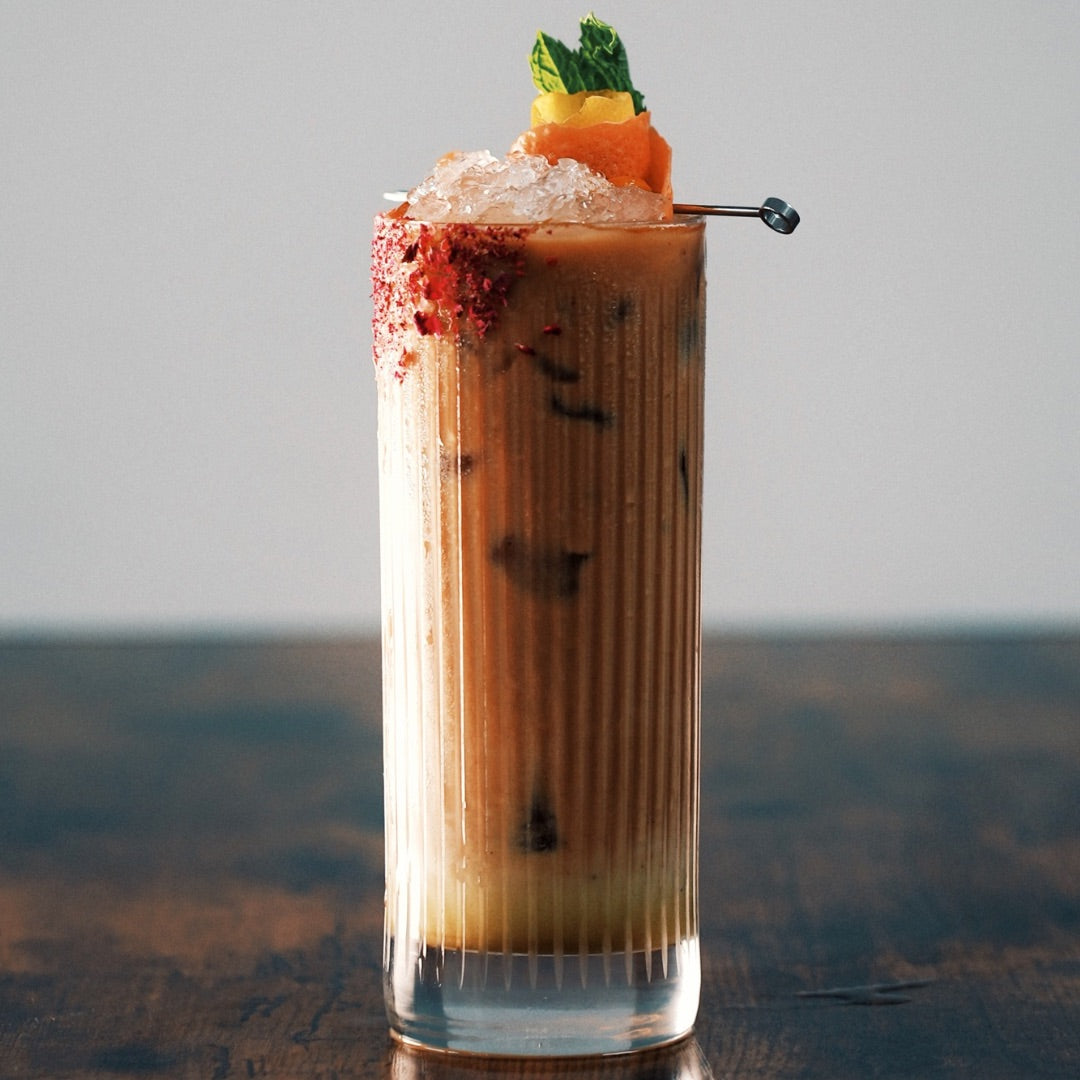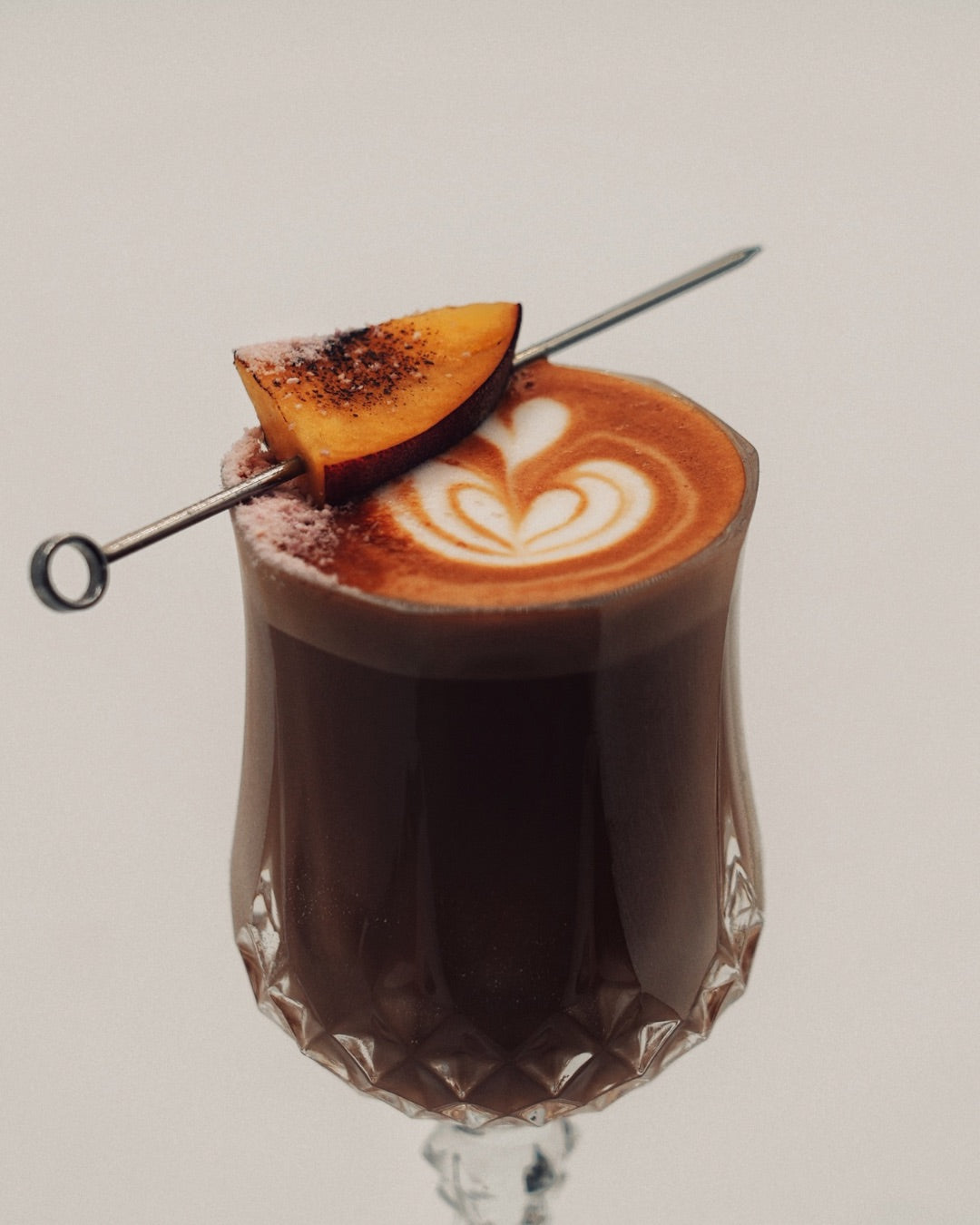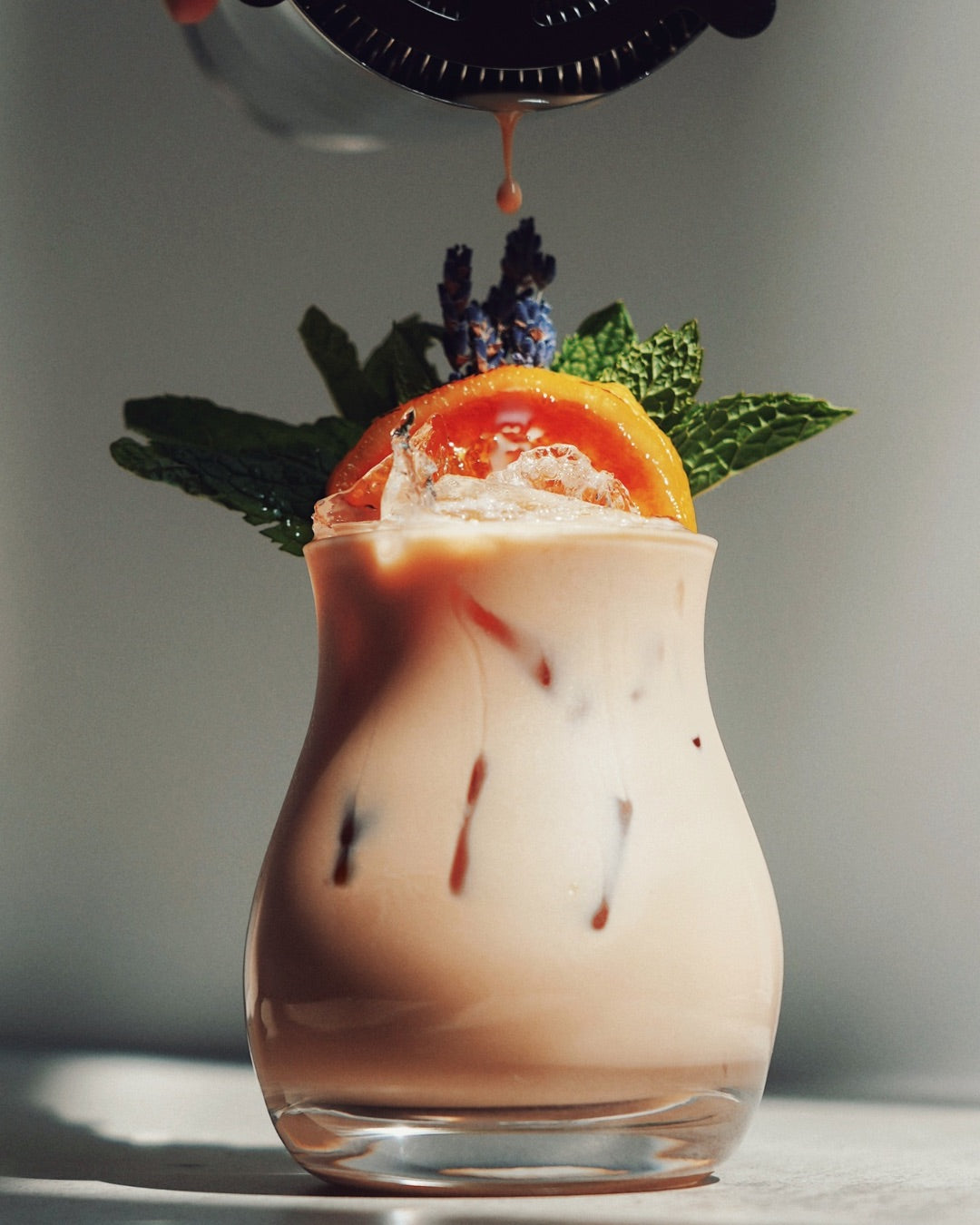So. Fancy coffee drinks. Signature beverages? Mocktails? Coff-tails? Playgrounds of flavor?
What are we actually calling these things?
I tend to stick to the designation of signature beverage, due mostly to the fact that my early experience in drink development happened within the constraints of barista competitions. So for the sake of clarity as we dive into the inevitable word vomit that is my creative process, let's put a definition on what signature beverage means in this context.
Coffee Signature Beverage: A non-alcoholic drink that utilizes coffee as a base and aims to showcase the versatility of coffee's flavor profiles.
Brilliant. Now that we have that cleared up, let's jump into how I approach these sorts of drinks. In actuality, when creating new drinks, all the sections that I'm about to differentiate and break down are happening simultaneously but I've done my best to give them some sort of hierarchy. At the end of the day, every recipe and drink developer's process is going to be different so use all of this information as a suggestion rather than a rule.
The Signature Beverage's "Mood"
The first thing I think about when creating a signature beverage is what sort of tone I want to set with the drink. What I want the person enjoying it to feel.
Is this a drink that's going to refresh someone? Make them feel sophisticated? Is it comforting? Familiar? Out of their comfort zone and adventurous?
One of my favorite pieces of packaging design I've ever seen lives on the back of Smith Tea Lord Bergamot sachets. Underneath the fold of the wrapper is the sentence, "Best enjoyed in the heat of a summer day." This is the essence of what I'm trying to figure out at this stage of development. The story and tone that's going to then trickle down into every following decision.
The Primary Flavor Profile
More often than not, I think about flavor in terms of color and while this isn't uncommon, I've learned it's not everyone's mode of operation. Regardless, the second decision I usually tackle is what my primary flavor component is going to be, or, more accurately to my own process, the color profile of the drink. Below are a few examples to get your brain spinning.
- Tropical (orange, yellow, light pink): Pineapple, mango, papaya, citrus fruits
- Floral (pink, red, purple, light blue): Tea flavors, lavender, chamomile, rose, orange blossom
- Herbaceous (green, umber, tan, pale purple): Rosemary, thyme, mint, celery, sage
- Confectionary (deep brown, silver, cream, beige): Chocolate, vanilla, caramel, sugar, coffee
Of course, there are an endless directions you could go with selecting a primary flavor profile but I do think the ones listed above are traditionally the easiest for folks to approach, both from a creation and consumption standpoint.
It's at this point that you're able to start really making concrete decisions about the ingredients that are going to be in your drink. While the iteration process is often long and arduous, I find it beneficial to initially select two or three base ingredients that you're going to begin experimenting with (with the knowledge that you can try out others later if need be). For example, when I was developing my signature beverage for the 2024 US Barista Championship, I wanted to create a tropical drink with a juice base. I knew I had to limit my initial range of testing ingredients in order to streamline the development stage so I chose to work around the flavors of orange and mango. Starting within these constraints helped ensure I didn't lose myself in testing every single tropical fruit juice I could get my hands on.
The Coffee Base Type
Alright, let's get into the meat of our drink. And by meat, I mean coffee.
I find this decision easiest to make after I've decided on the overall drink's flavor profile, not before. Essentially, there are two layers to this decision: what coffee are you going to use and what preparation method are you going to use. Let's look at some different brewing methods first.
- Espresso: Strong, intense flavor and body. Can often be used as a 1:1 spirit replacement in cocktail templates.
- Cold brew & concentrate: Low acidity, very "coffee" forward flavor. Great as a base for iced signature beverages. Cold brew concentrate can be a good substitute for chilled espresso, if you're lacking an espresso machine.
- Filter coffee: The flavor profile and body are highly dependent on what coffee is used. I traditionally build filter coffee drinks around the coffee flavor and not the other way around.
- Instant coffee: Predictable, easily adjusted, and great when you need to infuse coffee flavor without added liquid.
- Liquid concentrates: In the last five years, there's been an influx in liquid coffee concentrates on the market and if you're willing to wade through the ones that are less than stellar, you can find predictably useful options similar to instant coffee.
The second component to choosing your coffee is what sort of coffee are you actually using. Perhaps a naturally processed Colombian Pink Bourbon? A washed Kenyan? A lychee co-ferment? Honey-processed Wush Wush? What's the roast profile? The possibilities are endless. There are no rules to what coffee will go best in any one drink but I just caution you to be intentional and thoughtful about your selection. A delicate, floral drink can easily be washed out by a dark roast when a lighter, more fruit-forward coffee may have shined.
The Complimentary Flavors
To avoid your drink being entirely one note, it's important to include secondary and complimentary flavors. Often, these will be flavors that live on the "opposite" side of your drink's primary profile. The goal is to create complexity in each sip, for the final drink to be greater than the sum of its parts. However, I'll caution you to not go too ham on your secondary flavors. Adding flavors for the sole sake of saying they're in the drink does more harm than good if said flavors don't actually contribute/elevate the drinking experience.
Let's return to my 2024 USBC signature beverage as a continued example. Very early, I settled on using a 50/50 blend of orange and mango juice as my primary ingredient. Both of these juices have a heavy body, very orange flavor profile, and recall quite a bit of tropicality. If I were to just continue down this vein and continue adding ingredients like passionfruit papaya, I'd likely not only wash out my initial flavors but the drink's balance would be thrown into total disarray.
A better strategy is to experiment with ingredients that add a balancing element to the drink.
- Acidity: Bright, cutting flavors, most readily found in citrus.
- Sweetness: Syrups, cordials, fruit juice.
- Salinity: Salt or salty ingredients as a flavor enhancer.
- Aroma: Aromatic ingredients/garnishes to transform the perceived flavor.
- Spice: Rounding out brighter drinks with warming and baking spices.
- Heat: Adding actual spice (chili, pepper, etc)
You may have noticed that throughout all of this, we haven't talked about texture yet...
Buckle up, folks.
The Tactile & Texture
Boy, oh boy, this is my favorite part. I'm a self-described texture person, often to a fault. One of those people who would probably eat packing peanuts if they could.
However, I've been forced to settle for drinks that have some sort fun texture element instead (sigh). My necessitating for drink texture admittedly comes from barista competitions where a large component of your signature beverage's score results from identifying its tactile elements, meaning it's beneficial to create drinks that are easily identifiable. When talking about the tactile of the drink, there are three main things I'm looking at.
Weight/body: Where does the drink fall on the scale of tea to heavy cream?
Texture: What does the drink feel like on the palate?
Finish: What is the lingering effect of the drink after each sip?
I, like most people, have certain techniques and tactile preferences when it comes to drinks and I'll list some below with the caveat that this list is constantly expanding and evolving.
- Sparkling/bubbly: Carbonation, force carbonation, fermentation
- Fluffy: Nitrogen infusion, foams, egg whites
- Smooth: Dairy additions/bases, straining
- Syrupy: Gomme syrups, cordials
- Silky: Clarification
- Slushy/Crystalline: Blending with ice and emulsifiers
There are definitely drinks that don't require an explicit texture element, where the ingredients alone combine to make something delightful, however I will never negate thinking about texture during development even if it doesn't lead to anything.
The Presentation & Garnish
This is the part where I really like to play. As a die-hard theater kid (surprise, surprise), I love a little bit of drama in my signature beverages. Or a lot. But who's keeping track?
A little anecdote before we dive into this section though. During my training for the 2022 US Barista Championship, there was one moment that changed my view on drink presentation indefinitely. It happened about two weeks before Nationals when I was doing a full routine run through to one of my coaches, Andrea Allen (2020 USBC & 2021 World Barista Runner Up). I had developed a lovely little limoncello-inspired espresso drink that was served in stemmed champagne flutes and, unbeknownst to me, I had spent so much time working on the drink that I'd become somewhat blind to it. Like when you say a word too often and it no longer sounds like anything remotely intelligible.
Immediately after I finished the run through, I expectantly waited for Andrea's notes, positive that everything was perfect and there was no possible way to improve my drink courses. After a moment of thought, she said, "Do you think there's a way we can change the signature beverage presentation a bit? Because right now it's a brown liquid in a glass."
Ah. Yes. My first confrontation with the Brown Liquid Problem. She was absolutely right. For all the interesting flavors and textures I'd created within the signature beverage, it lacked any visual interest.
The Brown Liquid Problem: What arises when you add coffee, of any type, to a drink and are immediately greeted with a brown liquid.
Don't despair in the face of the BLP! This is where thoughtful garnishing and presentation comes into play. In my perfect world, a garnish should serve more than one function.
- Visually represent or call back to the flavors within the drink
- Example: An orange coffee soda garnished with citrus wheels
- Enhance the consumer's visual experience
- Example: The placement of edible flowers on a coffee sour
- Affect the taste experience through aroma
- Example: Smoking a sprig of rosemary in a latte directly before serving it
- Affect the taste experience through the glassware choice
- Example: Serving a drink in a glencairn glass to better funnel aromatics to the consumer's nose
- Provide a small bite that pairs with the drink
- Example: Garnishing with speared berries or fruits that can be consumed alongside the beverage
I'll be the first to admit and apologize for the fact that on occasion I'll add a non-functional garnish that exists purely for aesthetics. It happens. While I won't begrudge you for it, should you choose to do so as well, I would suggest that it happen in less than 10% of your drinks.
Other Miscellaneous Components
Finally, here are an assortment of development considerations that I didn't feel fit into any one category.
- If you're serving your drink layered (such as floating an espresso atop a latte), how do you want the consumer to interact with it?
- If it should be stirred, have you provided a straw or stirring device?
- Are you going to incorporate color?
- Possibly a bright syrup or milk using natural food coloring (beet root, spirulina, butterfly pea powder, ube)
- What's the drink volume served?
- Complex and coffee forward drinks often benefit from being served in smaller amounts while lattes have much more flexibility in their size range
- Can your drink be served hot and cold? Or just one way?
- With coffee drinks, lattes in particular, the expectation is often that they can be versatile in temperature. Be clear on how its best enjoyed.
Final Thoughts
Ultimately, coffee signature beverages should be fun. Heck, coffee should be fun. That's the goal of all of this. Make whatever concoction delights you and then make it again. Or try something else.
So with that, I'll thank you for making it to the end of this veritable word tornado and, as always, suggest that you go sip and enjoy something that delights you.








